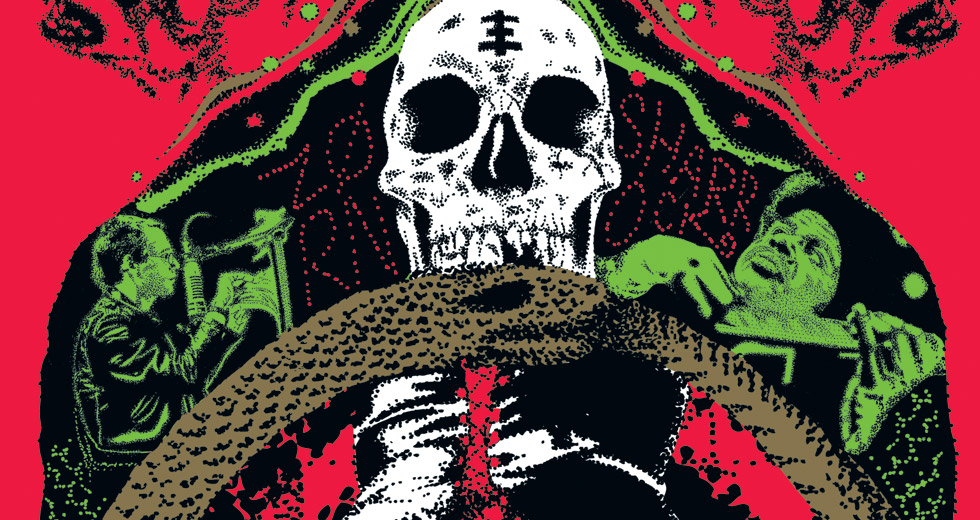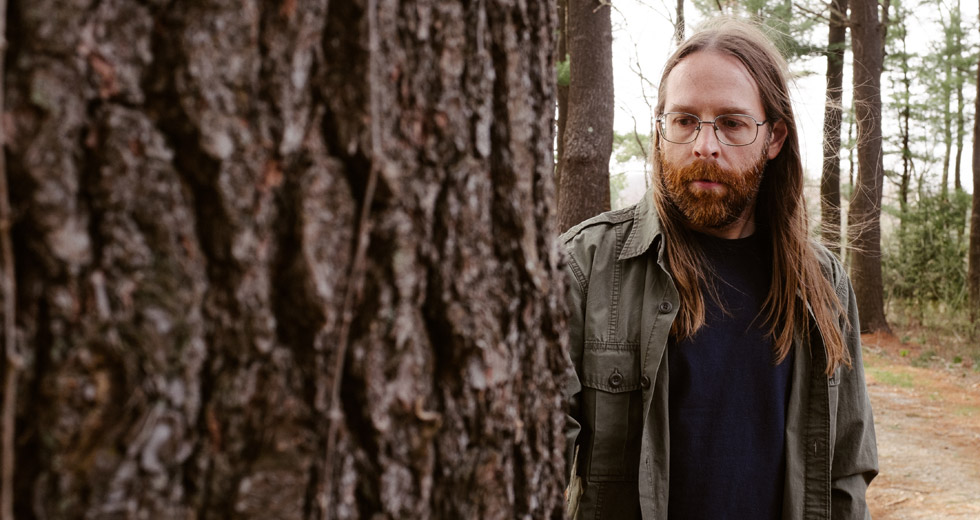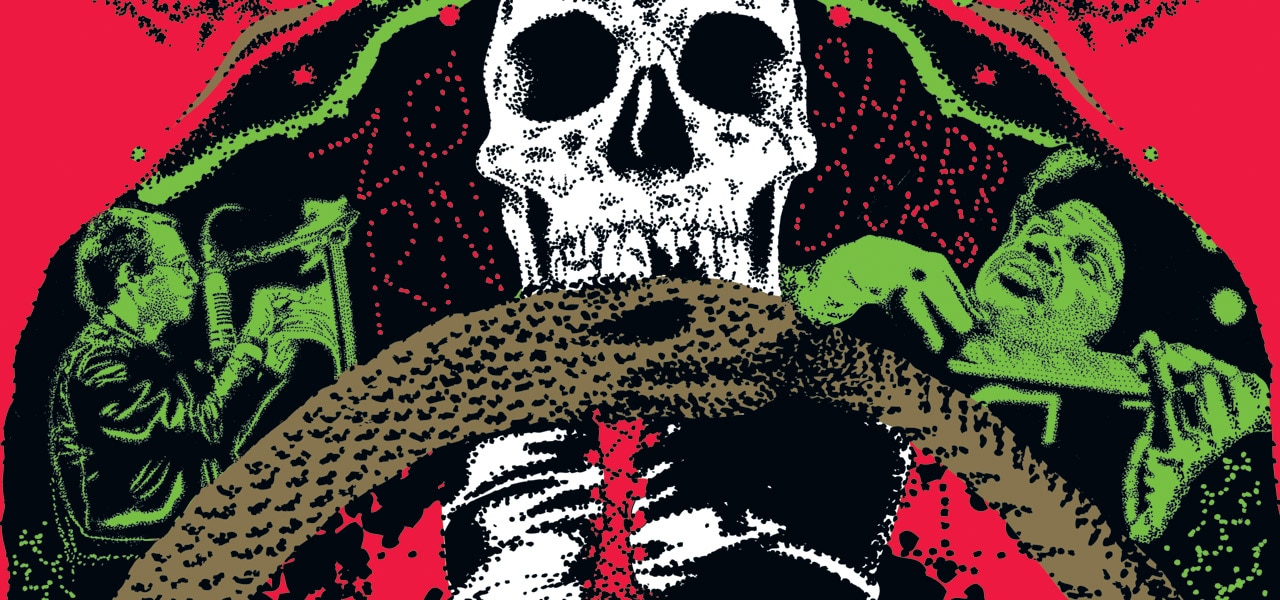
Black Magic: Jazz and Metal’s Unholy Union
The Puck Building, New York City; New Year’s Eve 1989
John Zorn sits onstage, smiling fiendishly. Clad in a “Die Yuppie Scum” T-shirt and blue camo pants, the saxophonist, composer and leader of Naked City calmly taps out time on his knee and mayhem ensues. Drummer Joey Baron executes jackhammer blast beats as guitarist Bill Frisell plays gnarled, surf-gone-prog riffs; meanwhile, the Japanese vocalist (and Boredoms founder) Eye shrieks and convulses, egged on by Zorn’s blaring alto sax. The concert lasts more than two hours – weaving in classic soundtrack themes and bite-size references to country and classical – but many of the pieces clock in under a minute. In case the message isn’t already clear, Zorn announces a composition entitled “Jazz Snob Eat Shit.”
An apartment in Prospect Heights, Brooklyn; January 2011
I’m seated in the living room of Craig Taborn. Taborn is a jazz pianist, one of the most well-respected in New York, or on the planet. He’s worked with legends ranging from bassist Dave Holland to former Art Ensemble of Chicago member Roscoe Mitchell. Taborn is playing DJ for the afternoon, and what he wants to hear at the moment is Cryptopsy, a Montreal band known for its ultra-technical, uncommonly deranged approach to death metal. We stare at the speakers, wrapped up in the sound. Taborn weighs the relative merits of the different vocalists the band has employed; former member Lord Worm is the fan favorite, but he votes for bullish mid-period barker Mike DiSalvo. I listen more and mull his point.
Death by Audio, Williamsburg, Brooklyn; February 2013
Two musicians are locked in a fully improvised duet. Their approaches are so sympathetic that the sound pours forth in a unified stream. The guitarist is Mick Barr, a 30-something player known for reconciling top-velocity metallic shred and insular experimentation in projects such as Orthrelm and Krallice. On drums is Marc Edwards, a 63-year-old drummer who has worked with Cecil Taylor, David S. Ware and other free jazz legends over the course of a 30-plus year career. Together the two achieve a brutally beautiful sort of trance music.
In a broad sense, jazz and metal couldn’t have less in common: one is an African-American art form hinging on virtuosic, moment-to-moment interplay; the other is a predominantly white music built around paradigms of volume and density. But as the examples above suggest, the two genres share a rich overlapping history. The early crossover between jazz and aggressive rock, spearheaded in the late ’60s by musicians such as drummer Tony Williams and guitarist John McLaughlin, was a literal hybrid: the souping up of small-group acoustic post-bop with a rumbling electric engine. The pioneers of the movement encountered flak from jazz purists, but in retrospect, their so-called fusion made perfect sense. It reconciled two idioms descended from black American music – recall that the de facto first metal band, Black Sabbath, began life as The Polka Tulk Blues Band – each one a staunchly organic style based on real-time musician-to-musician interaction, the art of the harmonious jam.
In a broad sense, jazz and metal couldn’t have less in common. But the two genres share a rich overlapping history.
In the ensuing decades, the jazz/metal crossover branched off in countless surprising directions, from the forbidding, improv-driven art metal of early- to mid-’70s King Crimson to the Grateful Dead–inspired free punk that guitarist Greg Ginn undertook a decade later on Black Flag releases such as The Process of Weeding Out. During the early period of Naked City, founded in ’88, John Zorn focused on brain-scrambling juxtaposition, gleefully colliding grindcore, free jazz, and atmospheric exotica. Later, Zorn would join forces with Bill Laswell – architect of Last Exit, his own fearsomely raw noise-fusion outfit featuring free jazz guitarist Sonny Sharrock – and Napalm Death drummer Mick Harris in the alternately hellacious and dubbed-out trio Painkiller.
In current-day New York, a new kind of jazz/metal interplay is brewing. Musicians such as Mick Barr, drummer Weasel Walter, saxophonist Jon Irabagon and various others are helping to usher this disparate movement into a lush, weird spring, spawning fresh hybrids – not jazz, not metal, not fusion exactly, but the beginnings of an autonomous aesthetic.
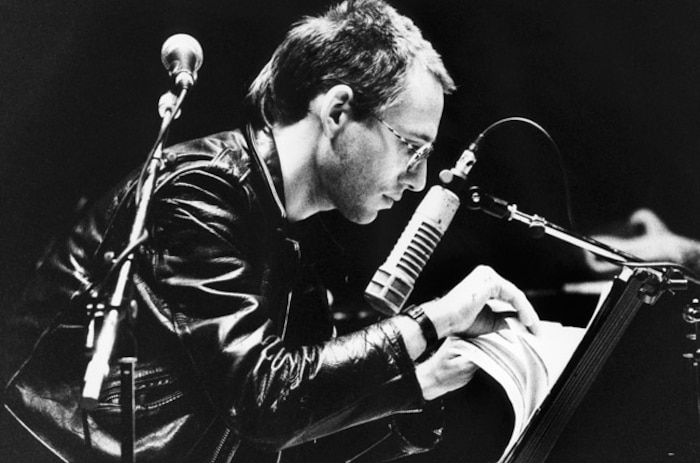
It’s worth asking what’s special about the current moment. Why are conditions right for a new kind of jazz/metal intersection? First, metal has grown steadily more respectable over the past decade. In retrospect, Naked City’s middle-finger iconoclasm seems almost quaint. Today, you’d have to go a lot further than a grindcore-jazz hybrid to scandalize any well-informed NYC music fan. We live in an era where critics regularly review doom and hardcore records on Pitchfork and in the New York Times; where documentaries and art shows fixate on the iconography and principal players of Norwegian black metal. Perhaps even more so than jazz, metal is now viewed as a cutting-edge genre, a canonized art music, a style you need to know if you want to be in the know.
During the ’80s, the era of bullet belts and back patches, this notion would’ve been unthinkable. (In 1990, metal was literally on trial: that was the year two Nevada families sued Judas Priest for supposedly inspiring their sons to shoot themselves via alleged subliminal messages.) At the same time, jazz continues to grow ever hipper and more eclectic. In NYC, young, pop-savvy listeners flood gigs by Jason Moran, The Bad Plus, Vijay Iyer and Robert Glasper – all historically minded jazz artists who also engage meaningfully with the present – and flock to the annual Winter Jazzfest, a festival that regularly embraces Nels Cline, Vernon Reid and other players equally well-known in the jazz and rock spheres. While the proverbial jazz snob might still exist in some ivory tower, he or she certainly isn’t the norm.
Today, you’d have to go a lot further than a grindcore-jazz hybrid to scandalize any well-informed NYC music fan.
The jazz/metal overlap has evolved to the point where the crossing of this boundary doesn’t automatically connote some stodgy idea of transgression, where players from both sides can finally step back and assess just how much they have in common, locating the affinities that lie underneath the obvious surface differences (image, decibel level). As mainstream pop grows ever more synthetic, as DJs and producers inherit the rock star mantle, as laptops and loops supplant guitars and drums as the primary engines of DIY music-making, jazz and metal come to seem more and more like sibling idioms.
Both genres thrive on highly specialized, unmistakably human-centric technique – think of a death metal drummer’s double-kick chops, or his jazz counterpart’s four-limbed independence. Both privilege the small, tight-knit ensemble, in which musicians interact with the speed, precision and power of pro athletes. And both enjoy profoundly devoted fan bases, support systems that encourage artists working in their respective genres to stretch and explore. Thanks to Tony Williams, John McLaughlin, Robert Fripp, Greg Ginn, John Zorn and many others, the ice has shattered into bits. Today’s counterparts are sifting through the rubble, searching for what comes next.
The collective known as Sunn O))) is an important touchstone for this new wave of jazz/metal crossover. The group’s basic M.O. is to elongate the zombified plod of doom metal into sprawling drone epics, a strategy that’s helped make them a key nexus among players from various experimental-minded scenes. On 2009’s Monoliths & Dimensions, core Sunn O))) members Stephen O’Malley and Greg Anderson roped in guests including vocalist Attila Csihar, best known for fronting notorious Norwegian black metal band Mayhem, as well as trombonist Julian Priester, who has recorded with jazz greats such as Herbie Hancock, Max Roach and Sun Ra over a 60-year career. The results ranged from the band’s signature abstracted doom to a more placid approach. The record’s final piece, titled “Alice” and dedicated to Alice Coltrane, concludes with Priester soloing over a shimmering ambient passage.
The cameo harked back to a 2008 LP by acknowledged Sunn O))) forebears Earth, The Bees Made Honey in the Lion’s Skull, which incorporated renowned jazz guitarist Bill Frisell into its desolate slo-mo twangscapes. It would be tough to peg either of these records as jazz or metal, and yet DNA from both genres is traceable in each. Works like these hint at the vast potential still remaining in so-called fusion. Sunn O))) in particular seems to be seeking an inter-genre soundspace – a purely textural experience, a sound to go swimming in.
Various groups currently active in NYC are engaging in a similar pursuit. The trio of Mick Barr, saxophonist Jon Irabagon and drummer Mike Pride demonstrates how jazz and metal musicians are bonding over fresh aesthetic ideals, with raw aggression being only one component of a broader sonic palette.
Orthrelm’s OV seems driven by infernal monomania, as if the musicians were simultaneously afflicted by the same nervous tic.
Irabagon and Barr come from different worlds. The saxophonist first attracted wide attention in 2008, when he won the prestigious Thelonious Monk International Jazz Competition, a contest that celebrates a staunchly traditional sort of jazz virtuosity. The victory netted Irabagon a recording contract – the album he released a year later, The Observer, toed the party line. It featured pianist Kenny Barron, bassist Rufus Reid, and drummer Victor Lewis – all esteemed veterans of the jazz mainstream – and a sound that looked back to post-bop’s mid-’60s heyday. Irabagon turned up in promotional photos wearing a natty suit.
To a casual spectator, it would’ve seemed like he was aiming for a straightlaced jazz career. But The Observer was actually the second of two major statements Irabagon issued in 2009. The first was an extended duet with Pride, I Don’t Hear Nothin’ But the Blues, a dauntingly extreme statement that was nevertheless one of the most engaging releases of the year. Reviewing the album in Time Out New York, I wrote: “Sax-percussion duets often nod to the John Coltrane / Rashied Ali free jazz classic Interstellar Space. But to find an analogue for this [record], you’d have to look to 2005’s OV, a remarkable work of sustained minimalism by the post-metal duo Orthrelm. I Don’t Hear Nothin’ But the Blues – like OV, a continuous piece of nearly 50 minutes – seems driven by infernal monomania, as if Irabagon and Pride were simultaneously afflicted by the same nervous tic.”
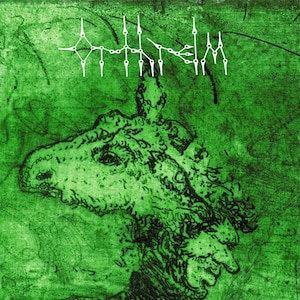
Like Irabagon, Mick Barr has been known to alter his aesthetic framework at will. The guitarist emerged from the D.C. post-hardcore scene in the late ’90s as half of the esoteric math rock duo Crom-Tech. Orthrelm was Barr’s next major project. It focused on hyper-complex, non-repeating miniatures – like the work of a thrash-metal band locked for years in a lightless basement and driven insane. On OV, though, Barr and his bandmate, drummer Josh Blair, turned their attention to obsessive, grand-scale minimalism.
Irabagon invited Barr to join him and Pride for some shows, and eventually the project became a trio. Like the 2009 Irabagon/Pride duo, the 2012 debut of this new lineup, I Don’t Hear Nothin’ But the Blues Volume 2: Appalachian Haze, consists of a single album-length improvisation. The players zero in on densities and qualities of sound. Irabagon’s ululating sax entwines with Barr’s continuously unspooling guitar squiggles while Pride runs interference, juggling frenzied free-time rolls and what sound like rhythmic allusions to Gary Glitter’s “Rock and Roll Part 2.” The record hinges on the same principles that drive most good improv: attuned listening, sensitive response, varied dynamics. These players come from different backgrounds, but here they leave idiom behind. It’s a humble endeavor, one that doesn’t foreground the idea of splicing or juxtaposing genres. Irabagon, Barr and Pride are simply playing together, exchanging sonic ideas and constructing a group sound from scratch.
That unpretentious spirit also drives several other Barr projects, including his superbly matched duo with Marc Edwards. The team-up came about thanks to Weasel Walter, a drummer and composer who settled in Brooklyn a few years back, after long stints in Chicago and Oakland. If the current wave of jazz/metal crossover in NYC has a ringleader, it might be Walter. The 40-year-old is a connoisseur of all varieties of extreme music – black metal, experimental improv, modern classical – and an evangelical fan of those whose work he respects (like Barr). At the same time he’s an enormously prolific musician, documenting his work on his own ugEXPLODE label.
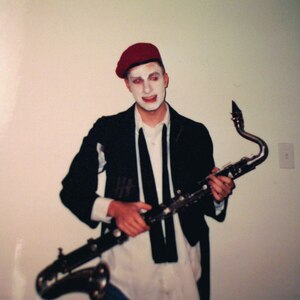
More so than Irabagon or Barr, Weasel Walter has performed extensively on both sides of the jazz/metal divide, gigging with veteran improvisers like Evan Parker and Marshall Allen, as well as with Chicago thrash-doom band Lair of the Minotaur and maniacally intense San Francisco noise-rock group Burmese. At the same time, he isn’t a committed fusionist. Walter’s best work tends to fall into one or the other camp: a series of aptly self-described brutal-prog releases by his former band The Flying Luttenbachers (peaking with 2006’s excellent Cataclysm); Horrorscenscion, a 2012 LP by the instrumental tech-metal trio Behold... the Arctopus; free improv work with players such as reedist Vinny Golia and guitarist Henry Kaiser. Sometimes you’ll hear techniques from one realm seep into the other, as when Walter employs snippets of blast beats and double-kick drumming in his trio with guitarist Mary Halvorson and trumpeter Peter Evans, but such crossover always stems naturally from the context at hand. He knows jazz; he knows metal. He reserves the right to blur these disciplines, or keep them compartmentalized, as the situation demands.
Craig Taborn is one of the most knowledgeable metalheads I’ve ever met – a listener who’s equally well versed in thrash staples and the furthest reaches of the metal vanguard.
Walter tends to broadcast his dual citizenship – proudly sporting grindcore t-shirts at his avant jazz gigs – but there are other quieter corners of this overlapping territory, where one genre seems to exert a strange kind of subterranean pull on the other. Craig Taborn is an interesting case study. A few years ago, I started spotting Taborn at metal shows. In 2010, he scheduled a duo gig with forward-thinking Canadian death-metal guitarist Steeve Hurdle at The Stone, John Zorn’s East Village venue. (The concert was canceled due to visa issues and tragically, Hurdle passed away in 2012.) I began a correspondence with the pianist and eventually interviewed him. Taborn is one of the most knowledgeable metalheads I’ve ever met – a listener who’s equally well versed in thrash staples like Slayer and Voivod and the furthest reaches of the metal vanguard: California’s Spaceboy, Norway’s Virus.
But while he’s worked in rock-oriented settings – such as the Gang Font featuring Interloper, a loopy fusion group with Bad Plus drummer Dave King and former Hüsker Dü bassist Greg Norton – the pianist’s output doesn’t overtly reflect an extreme metal influence. The title of Taborn’s enthralling 2011 solo piano release, Avenging Angel, evokes a grandly sinister, metal-related sensibility; sonically, though, the crystalline, eerie, almost alien-sounding pieces on the record more closely resemble contemporary classical music than either jazz or metal. As I sat with Taborn discussing Cryptopsy and other esoteric bands, the notion of trying to pin a given musician into one genre or another started to seem more and more absurd. Is it really all that surprising that an open-minded artist would be omnivorous in his or her tastes? Or that this diversity might not be apparent on the surface?
What’s clear is that jazz and metal remain magnetized in some fundamental way, and that this attraction has only strengthened over time. All sorts of curious compounds have emerged – psychedelic prog-jazz, free-form punk, improvised grindcore with screaming saxophone – and more are arriving constantly. Irabagon, Barr and Walter are just three representatives of a larger community of players currently exploring the jazz/metal overlap in NYC, including tuba player Dan Peck, banjoist-guitarist Brandon Seabrook and cellist Joe Merolla.
In recent years, John Zorn has turned away from the shock theater of Naked City, focusing on projects – such as the Moonchild ensemble and the series of compositions heard on 2011’s Enigmata – that combine jazz and metal elements in still jarring yet more holistic ways. Meanwhile, Taborn and other like-minded players, like pianist Matt Mitchell and drummer Dan Weiss, maintain a steady diet of extreme-metal listening while excelling in the progressive jazz sphere. The upshot is that it’s becoming more and more difficult to assess one of these styles without seriously considering the other; they once seemed like distant cousins and now look more like blood brothers. Jazz is thriving. Metal is thriving. And the territory between them is now, finally, starting to feel like a self-sustaining ecosystem.
Hank Shteamer covers music NYC music weekly for Time Out New York. A version of this article appeared in The Daily Note, a free daily newspaper distributed in New York during the 2013 Red Bull Music Academy.
